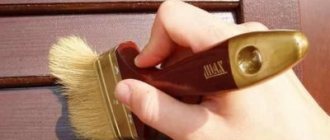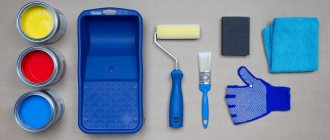Multi-colored light bulbs are useful both outside and inside the home. They can decorate the front door, veranda or garden gazebo. A colored light bulb screwed into a night light or room lamp adds coziness to the room.
Garlands of light bulbs painted in bright colors are useful for New Year's celebrations, birthday parties or other celebrations. By painting, car owners can change the color of their turn signals from white to yellow, as required by traffic regulations. In this article I will tell you how to paint light bulbs with your own hands, following a simple technology.
The history of chrome plating
A mirror emulsion, which is applied in compliance with a whole set of rules and conditions, creates a specific coating that completely imitates perfectly polished metal. This effect is created due to the fact that the special paints contain the smallest particles of the metal itself, as well as a unique varnish. It is thanks to this composition that when applied, a thin layer is formed, which forms a very smooth and shiny surface on almost any object. The range of applications of this new product is increasing every year, and the popularity of this invention is only increasing.
Chrome products have always attracted attention with their shine. Chrome plating technology developed rapidly in the mid-twentieth century. This type of coating has become very widespread in plumbing. With proper care, this type of item always pleases the eye with its brilliance and irresistibility.
At one time, chrome plating was used extremely widely in the automotive industry. North American automakers especially distinguished themselves by this in the 50s and 60s of the last century. If you look at the cars of those years, you will notice that they literally shone with an abundance of chrome. Bumpers, moldings, side view mirrors, many overhead parts - everything is covered in chrome. Aesthetically it looked great, while providing a fairly good anti-corrosion coating.
However, achieving such an effect was possible only when manufactured in a factory and with strict adherence to technology. Deviation from the technological process threatened that the chromium would peel off from the metal. There was another drawback at that time - chrome plating could only be applied to metal surfaces.
Progress does not stand still. Today, chrome plating of various surfaces is possible. However, real chrome plating still remains the lot of manufacturing enterprises. This is due to the fact that the application of chromium metal is an electrical process.
An alternative to the technology of applying metallic chrome is chrome effect paint. Two options are possible here. This is the use of compositions using a traditional spray gun and liquid in cans. The first option can be divided into simple painting and using heat treatment.
Problems you may encounter
In coloring, or rather in durability, there is only one significant problem - the type of light bulb, and most importantly the incandescent temperature.
There are 5 main types of lamps:
- incandescent - service life is about 1000 hours. They glow yellow. Available with a matte surface for better light diffusion. Heats up to 250.
- halogen - service life about 4000 hours. Produces low-frequency noise and is used only for special purposes: spotlights, headlights. Heats up to 200.
- luminescent – service life 5 years. High light output, many shades of light. Heats up to 70.
- energy saving - service life depends on the manufacturer. There are 3 color spectrums: soft, cool and daytime. Heats up to 50.
- LED – service life 11,000 hours. White LEDs are used in everyday life. Heat up to 50.
One very important fact can be gleaned from these basic data.
Any paintwork material tends to collapse at high temperatures. Therefore, the first thing you should pay attention to is the type of light bulb and the temperature resistance of the selected paintwork material.
Potential problems
The main problem that you may encounter after painting a lamp is high temperature. A 25-watt incandescent lamp or fluorescent device heats up to 100 degrees. The surface of a halogen 275-watt light bulb heats up to 250 degrees. The LED device heats up quite moderately - up to 35 - 50 degrees Celsius.
Halogen appliances cannot be painted. As for other types of lamps, in most cases the paint coating does not withstand the temperature and is destroyed. After losing transparency, the lamp will heat up unevenly, which sharply reduces its service life.
Problems
There is only one problem with painting light sources - their temperature. Let's give some values.
| Type | Surface temperature |
| Incandescent lamp, 25 watt | 100С |
| Incandescent lamp, 40 watt | 150С |
| Incandescent lamp, 75 watt | 250С |
| Halogen, 275 watts | 550 C |
| Energy saving (compact fluorescent) | 100С |
| LED | 35 - 50C |
It is clear that dyes not intended for high temperatures will quickly fade in such conditions; a layer of paint will remain transparent for only a few minutes. Compact fluorescent and LED lamps, however, heat up very moderately.
The plastic diffuser of the LED light bulb hardly heats up. Only the power converter gets noticeably warm.
Please note: halogen light sources cannot be painted. At all. A decrease in the transparency of the bulb will lead to its increased and, more importantly, uneven heating, which will inevitably lead to failure.
Why paint a light bulb?
Before choosing what to paint a light bulb with, you should clarify whether the method is suitable for achieving your original goals. Painting lighting fixtures is usually becoming an alternative to purchasing ready-made elements. Colored dyes are most often used for:
- Eliminating their possible theft at the entrance. They are usually stolen for further resale or use at home, but lamps painted in a different shade or darkened are not suitable for this. This reduces the risk of theft of lighting in the house.
- Creation of light music. Using lamps of different colors will help create an unusual atmosphere in the house, which is suitable for creating home parties and discos.
- Zoning of space. You can use different shades to highlight or emphasize different areas in the apartment. The paint used for light bulbs is not bright, but muted tones are suitable for changing the color scheme of the room.
- Decoration of rooms. Creating small illumination of shelves or other elements can be done by changing the color of the lighting, which usually looks impressive.
Instead of painting the light bulbs yourself, you can buy ready-made devices. However, keep in mind that their prices vary greatly - with home painting you can save up to 60 percent of the price. In addition, you can choose an unusual color scheme, which is not always available ready-made. The initial goals for coloring a light bulb may be different, but keep in mind that if the dye is used correctly, it does not lose its technical characteristics, which is why it can be used for regular room lighting, even after repainting it red. This is interesting: painting organic glass.
Example of using colored light bulbs
Why is this necessary?
But in fact, why would a person of sound mind and good memory paint lamps?
The list of possible reasons is quite impressive.
- The most obvious motive is the fight against theft . Everyone is familiar with the problem of dark entrances. The cause of darkness in most cases is theft of a lamp. Painted in any color, it will become unsuitable for sale on the market or for lighting an apartment.
- The construction of color music is another case when it is impossible to do without colored light sources. A reasonable minimum is three lamps of different colors.
Captain Obviousness suggests: in this case, instead of colored lamps, you can use color film filters.
- All kinds of lighting systems for instrument panels and dials with a colored light source look much more impressive.
Why not just get random colored lamps? Do you often see them in hardware stores? Where they are, their price differs from ordinary white ones by 2-3 times.
Colored light bulbs are rare and quite expensive exotics.
Effective painting methods
In order to change the color of a product, it is recommended to use highly effective painting methods. The best solution is to use specialized paint, which is created specifically for painting glass objects.
Ballpoint pen paste
If you don’t have time to find special paint, you can use ballpoint pen paste. To carry out staining using this method, you must perform the following steps:
- Take the stick with the paste.
- Remove the tip and extract the paste.
- Using a brush, apply the paste to the light bulb.
You can use either a blue or any other pen as a source of paint. The final result will depend on the amount of paste applied. It is worth understanding that using only ink from a ballpoint pen you will not be able to perfectly darken the product.
Nail polish
Using nail polish, low-power light bulbs are painted that do not heat up very much (the temperature during operation does not exceed 100 degrees C). The varnish has pronounced adhesion and durability. It can also be used to paint the entire surface evenly. You can use varnishes of any color, from yellow to red and green. Clear varnishes can be used as a base for other colorants. After applying the varnish, any other paint will adhere much better and with higher quality to the surface of the light bulb.
PVA
PVA glue is a good base for applying any coloring matter. If a high-quality result is required, it is recommended to create a layer of PVA before applying paint. Next, you can color the light bulb with ballpoint pen paste or special ink.
Auto enamel
Automotive enamel is a specialized paint that is sold in the form of an aerosol. Its advantages are good adhesion, convenience, high application speed and durability. Auto enamel is applied in a thin layer to achieve the desired darkening effect. You can find paint of any color on the market without any problems.
Application is carried out from a distance of 30-50 cm. Before this, the can is thoroughly shaken. It is important to make the layer thin so that the glass of the light bulb does not lose its transparency. If the layer is too thick, light will not pass through it.
Stained glass paints
Stained glass paints are created specifically for painting glass objects. With their help, you can give the glass the desired color while maintaining its transparency. To change the color of the light bulb, water-soluble stained glass paints are used that can withstand high temperatures.
Paints are sold in tubes. Substances must be applied in strict accordance with the instructions. You will first need to prepare the surface by cleaning and degreasing it. To give the light bulb a special look, purchase fluorescent paints with sparkles.
Tsaponlak
Tsaponlak is a varnish that is used to coat metal products and microcircuits to protect them from negative external influences. It is possible to purchase both transparent and colored tsaponlac. Using a colored liquid, you can try to paint a light bulb. The advantage of this varnish is resistance to high temperatures and wear resistance. The downside is the small selection of colors (only red and green tsaponlaki are available for selection).
Organosilicon
Organosilicon paints are characterized by extremely high heat resistance. They can be applied to coatings, which will subsequently heat up to temperatures above 500-600 degrees C. Organosilicon is used to color powerful light bulbs, which become very hot during operation. Before staining, it is recommended to dilute the dye with a solvent, otherwise the glass will be darkened too much. You need to act based on the instructions for the specific silicone-based paint.
Solutions
Regular paint is not suitable for painting a lamp. Still, there are a number of solutions that can help solve the problem.
Ballpoint pen paste
To make a light bulb, for example, blue, you can use regular ballpoint pen paste.
You can do this as follows:
- Remove the tip containing the ball from the rod.
- Blow out the rod. This will help you extract the paste onto a paper sheet.
- Hold the lamp by the base and rub the paste onto the bulb.
In one of the Soviet technical magazines, the following method was proposed: dilute the paste in acetone, and apply the resulting liquid to the flask with a brush. This option is good because it allows you to control the saturation of the paint. However, keep in mind that liquid paint is difficult to apply on a smooth glass surface.
Advice! Instead of acetone, you can use other types of solvents (cologne or ethyl alcohol).
The light bulb can be painted using regular quick-drying nail polish. However, it should be remembered that the varnish can withstand temperatures up to 200 degrees, and then it begins to flow.
Only economy lamps or low power incandescent lamps can be varnished. The varnish is applied with the brush included with the tube. A cotton swab will do.
Advice! Clear varnish creates a layer with good adhesion. Paste from a ballpoint pen is already applied on top.
Moderately heated light bulbs are treated with PVA glue. The principle is the same as described above when it came to colorless varnish - creating a layer on which the dye will adhere well.
After the glue has dried, the surface is painted with ballpoint pen paste, inkjet printer ink or any water-soluble pigment.
Note! After drying, white PVA glue becomes transparent.
Auto enamel
Automotive enamel is also suitable for painting light bulbs. Car enamels are packaged in aerosol cans. Like varnish, car enamel retains its performance characteristics at temperatures up to 200 degrees Celsius.
The enamel is applied from a distance of 30 - 50 centimeters. The paint layer should not be too thick, as in this case the bulb will lose its transparency.
Stained glass paints
Stained glass paints are used to paint light bulbs. In order to make the right decision about which colors can be used to paint a light bulb and which ones cannot, you should know that only water-soluble dyes are suitable for firing.
Such paints do not ignite when heated. Increasing the temperature only strengthens the coating. The only significant drawback of stained glass paints is their high cost. A small tube (50 grams) costs an average of 200 – 250 rubles.
Tsaponlak
To give the light bulb color, tsaponlak is suitable. This substance is sold in radio stores. Tsaponlak was originally designed to protect tracks and soldering from short circuits.
Tsaponlak contains the following components:
- nitrocellulose;
- organic solvent;
- dye to add color to parts (optional).
Tsaponlak has a certain heat resistance, since the temperature of the parts during their operation reaches 150 degrees. The disadvantage of tsaponlak is the limited choice of color.
The varnish does not contain a dye, and therefore the color will have to be created through other components. For example, to get a red lamp, you will need transparent zaponlak and red paste from a ballpoint pen. The procedure for staining with paste is the same as described above.
Note! Using tsaponlak you can paint the lamp not only red, but also green. Zelenka is not suitable for giving the light bulb the appropriate color, since this medical preparation practically does not linger on the glass.
Organosilicon
Organosilicon-based paints and varnishes are used to impart color to coatings that are operated at elevated temperatures.
Comments
“Network publication “Woman’sDay.ru (Woman’sDey.ru)” Certificate of registration of mass media EL No. FS77-67790, issued by the Federal Service for Supervision of Communications, Information Technologies and Mass Communications (Roskomnadzor) December 13, 2021 16+.
Founder: limited liability company "Hirst Shkulev Publishing"
Editor-in-Chief: Dudina Victoria Zhorzhevna
Copyright (c) Hirst Shkulev Publishing LLC, 2021.
Any reproduction of site materials without the permission of the editors is prohibited.
Contact information for government agencies (including Roskomnadzor):
The need to paint a lamp is usually dictated by decorative purposes. Some people want to create a color music system, others need multi-colored lighting for a dashboard or room.
Colored lamps are sold in hardware stores, but the cost of such products is several times higher than regular light bulbs.
Most often, the consumer decides to purchase a standard incandescent lamp and paint it the desired color. So the question arises: how to paint a light bulb? This will be discussed in the article.
How and with what to paint an old chandelier
A chandelier is an interior item that can not only provide the necessary level of lighting in a room, but also become the main element of decor. But fashion, as we know, is a capricious lady, and psychologists recommend changing the decor in the house from time to time. Replacing furniture will be too expensive, but you can give your favorite chandelier a completely new look yourself and at minimal cost. Let's figure out how to paint an old chandelier and what you will need for this.
How to give new life to your favorite chandelier
Old chandeliers are not only dear to us as memories, but also of excellent quality. And updating a lighting fixture is much cheaper than buying a new chandelier, although modern chandeliers amaze with their variety of decor and aesthetic appeal. There are quite a few options for upgrading a chandelier. This includes painting metal parts and lampshades, replacing an old lampshade, and additional decor, with the help of which the lamp will acquire a special style and a completely new look.
Let's look at how to paint a chandelier, what is needed for this and the stages of the work.
Preparatory stage
Before you start work, you need to prepare everything. For painting you will need:
•primer, preferably acrylic (you can use another one, but be sure to use one that is intended for covering metal surfaces);
•a can of paint (acrylic aerosol). Metal elements with pearlescent, fluorescent coatings, metallic paints, patina, and hammer effect look great;
•gloves, rubber or thin textile, and a protective mask;
•degreasing composition (solvent, kerosene, acetone, etc.);
• dry and clean rags;
•painting tape.
Next, you should prepare the object to be painted. Let’s say right away that the chandelier must be removed, and it is highly advisable to carry out the work in the fresh air or in a well-ventilated area. First you need to hang the chandelier and unscrew all removable elements. Anything that cannot be removed and is not planned to be painted, cover it with tape or cover it with film. If you value your flooring, cover it, because paint cannot be avoided. Thoroughly clean the surface from contamination; if necessary, use detergents; allow the chandelier to dry. Degrease the entire surface.
Coloring stages
Alkyd enamel or acrylic paint is best suited for painting. The enamel holds up well and looks great, but you need to apply at least three layers. Artistic acrylic is quite unstable and must be varnished, but aerosol acrylic is ideal for this. It is enough to simply paint the chandelier from an aerosol can. Staining is done as follows:
• thin layers (optimally three layers) of aerosol primer are applied from top to bottom in wide stripes;
•shake the can several times to mix the paint;
•painting is done with broad strokes, and to avoid drips, paint in the direction from top to bottom;
•between applying layers you need to wait half an hour for the paint to dry;
•to obtain a more saturated color, apply more layers of acrylic;
•to give the product shine, apply a layer of varnish (acrylic) over the paint.
After this, you need to let the chandelier dry completely, and then you can assemble and enjoy the result.
How to paint chandelier shades
If everything is quite simple with metal elements, then the question of how to paint chandelier shades is somewhat more complicated, because they are made from a variety of materials. Updating lampshades is a creative process. You can create a truly original and unique item using lace and fringe, beads and beads, decorative chains and cords. If you take an old lampshade as a basis and decorate it, it will look original and extraordinary, and the fact that this miracle was made independently will inspire, delight and give the product a special value.
If you want to do painting or full coloring, but don’t know what you can use to paint the glass shade of a chandelier, let’s see what materials are best suited for this. First of all, it is worth considering that the paint must be heat-resistant (after all, the lampshades heat up quite noticeably), and not fade or “peel off.”
For painting glass, ceramic and plastic lampshades, the best paint is made on the basis of a plastic emulsion with the addition of finely ground pigment, known as acrylic. It is divided into two types: covering (opaque) and stained glass, which perfectly transmits light. You can buy such paint in specialized art and construction stores, but be sure to make sure that the packaging indicates that the paint is intended for painting glass.
Tsaponlak would also be an ideal option for coating glass shades. It is made on the basis of nitrocellulose and can be transparent or with additives of dye and plasticizers. The varnish has excellent qualities and can be applied to almost any surface. It is non-toxic, and the coating is wear-resistant and, as they say, “especially durable.”
You can completely cover the lampshade, or you can get creative and apply ethnic or abstract, geometric or floral designs. This will not only give the chandelier a new, fresh look, but also fit it perfectly into the interior of the room and emphasize the stylistic design of the room.
No matter how you decide to paint the chandelier, shades or base, the main thing is to follow a few rules: degrease all elements of the lamp, choose safe and heat-resistant paint and do not forget that everything in the room should be in the same style.
With a minimum of effort and maximum imagination, you will get your “old” chandelier in a completely new and beautiful form! To the list of articles
How to paint light bulbs for color music
To make a home disco happen, choose special paint products. They must be heat-resistant, safe and easy to use. These include:
- silicone paints;
- tsaponlak.
Organosilicon paints are sold in construction stores, and tsaponlak is sold in radio parts stores. Both products are intended for painting surfaces operating at high temperatures.
Cons: limited selection of colors. You can mix colored pen pastes with tsaponlak and apply them to the light bulb. But this method is not applicable to silicone paints.
In this article, you learned how to paint a light bulb using available products. Use our tips and enjoy the new interior of your room. By the way, a painted light bulb in the entrance will save you from darkness and petty thieves who steal them.
Painting a light bulb
The lighting of a room creates its atmosphere and regulates the emotional mood of its owners and guests. This way you can create a work room, or vice versa, a relaxation area. To decorate a space, lighting of different colors is often used, but its price is much higher than the price of standard lighting fixtures. Because of this, you need to learn how to paint the light bulb yourself.
Which means are not suitable?
Not all dyes are suitable for coloring a simple light bulb. The complete list of products that cannot be used for coloring depends on the specific purposes. To obtain the most attractive decorative result, it is necessary to use stable, heat-resistant stained glass paints, silicone or tsaponlac. To quickly create an anti-vandal lamp, paste from a pen is suitable.
Zelenka
Almost every person has a solution of brilliant green in their first aid kit. It is not recommended to use it for coloring, since it is not resistant to high temperatures, wears off quickly and does not allow for uniform darkening. When applied in a thick layer, the brilliant green darkens the glass too much, which is why the lamp ceases to fulfill its main task - illuminating the room.
Markers and felt-tip pens
It is extremely difficult to paint the entire surface of the glass with felt-tip pens and markers. In addition, they are extremely easy to wipe off the surface after application. Even alcohol-based markers can be removed from glass at the slightest touch. That is why coloring with felt-tip pens is not done when working with any lamps.
Expert opinion
Zakharova Irina Yurievna
Cleaning professional with 15 years of experience. Our best expert.
Ask a Question
Even if you manage to paint the glass with a marker, the product will greatly lose its brightness and will be unsuitable for lighting or creating light music.
How can you paint an LED light bulb?
Several years ago, a new product appeared on the electrical goods market - LED lamps. Due to their advantages, they are gradually replacing incandescent lamps.
- do not heat up to high temperatures, do not heat the room, eliminate the risk of burns when touched;
- consume less electricity;
- power surges in the network do not affect their light output;
- service life is 20–25 times longer than previous models;
- do not contain mercury or other substances hazardous to nature and humans;
- comfortable for the eyes, since the emitted light is as close as possible to daylight.
LED light sources are about 10 times more economical than incandescent lamps, so it is more profitable to make decorative illumination using colored lamps of this type. Which dyeing methods are best?
You can paint the LEDs with the following colors:
- tinted tsaponlak;
- ballpoint pen paste;
- clear tinted nail polish;
- water-soluble acrylic dyes;
- felt-tip pen or alcohol-based marker.
I note that LED lamps are not suitable for color music devices, since they are not able to change their brightness in proportion to the supply voltage. At the same time, the recommendations given allow you to paint any type of light bulbs with your own hands.
Source
Method 2
To create a photo in neon light in the second option, we will need a table lamp (preferably with a long leg) and an old T-shirt/rag of the color with which you want to illuminate your photo.
How to take a photo in neon light:
- Tie the fabric onto the lamp.
- Place the lamp on the side of you so that it is not visible in the frame.
- Turn on the lamp.
- Enjoy the neon lighting.
- You can set your camera on a timer or ask someone to take a photo of you in complete darkness.
If you want to create a neon light gradient, then equip a second lamp, wrap it in a fabric of a different tone and place it on the other side of you.
Tsaponlak
You can purchase this coating at a store specializing in radio components. The main function of the coating is to protect tracks and soldering from short circuits. Since the operating temperature of transistors reaches 150 degrees, the product is also suitable for coating light bulbs.
These are the simplest and most affordable ways to coat a rather capricious material - glass. The choice is narrowed several times if the question concerns light bulbs that burn often and for a long time, because not all dyes can withstand high temperatures.
How to paint an LED lamp
The method of painting an LED lamp depends on the type of its surface. Because this type of product generates less heat, more coloring agents are available. Even those dyes that can withstand only slight heating up to 100 degrees C are suitable. The main parameter that you need to pay attention to when selecting paint is its transparency and adhesion to glass. To preserve the brightness of the product to the maximum, both ballpoint pen paste and tsaponlak are suitable. There is no need to use expensive heat-resistant stained glass paint.
Coloring with paste
To color your pen blue, you can use paste from a ballpoint pen. To paint the lamp in the color of the selected paste, you will need to carefully remove the tip and blow the ink onto a sheet of paper or oilcloth. Then, holding the light bulb by the base, rub it with the leaked contents of the pen. You can control the intensity of the coating using acetone, cologne or alcohol.
Slowly changing color RGB LEDs and their application for display
Yes, yes, diaivaya, a very fashionable word on the Internet these days. DIY or made by hand our way. Life on Muska, I see, doesn’t calm down even in the New Year, so I decided to share my handjob too. Actually, I already mentioned these LEDs in my review of garlands, but I used them extremely successfully (as it seems to me), so it’s not a sin to write a separate review. The LEDs themselves, in fact, do not represent anything supernatural - ordinary-looking narrowly directed 5mm LEDs in a transparent housing. But inside there are actually three LEDs and a control chip that smoothly switches them, thus changing the color of the glow “across the rainbow”
video of how they work here:
Actually, this concludes the review of LEDs and we move on to the display.
After purchasing a 3D printer, I began to be interested in ready-made models for printing. Well, of course, the first thing I found was the site thingiverse.com. And on it, in particular, there is a wonderful night light “Magic Mushrooms - a lighted decoration”. Well, on the eve of the New Year, I decided to print a couple of pieces for gifts. Undoubtedly, this review would not have existed if I had not finished finishing off that model. More precisely, I printed several new parts and one to replace the used one - namely the back cover.
Unfortunately, in the original model the lid is made somehow stupidly and not only does it close awkwardly, but it also doesn’t hold well, moreover, there’s no way to put a holder for batteries in it. And so that it wouldn’t dangle or fall through, I printed a couple of 5x10x1mm plates that I glued with dichloroethane from the inside of the case so that the lid wouldn’t rotate. In addition, since my LEDs are highly directional, I printed caps for them from transparent plastic that diffuse the light.
These LEDs can be powered by 2 or 3 AA/AAA batteries. I actually checked both options - everything works, but at 2V it’s already difficult. But I don't think that these lights will be turned on so often and run for a long time that this will become a problem.
When developing the cover, I was guided by holders for 3 * AAA batteries purchased offline, and switches that came from China by mistake
My models are posted here: yadi.sk/d/KLTZkkDeN5xPpw
Well, actually, let’s start making a night light. Printing details:
The plates are already glued into the case, they are visible in the hole at the top and bottom. The lid rests on them; they prevent it from turning on the protrusions that are inserted into the grooves. The lid turned out funny, “surprised boy” is called The colors are a little wrong, there is something brown-carrot, browner than in the photo, I would, of course, like something even more natural, but that’s okay. However, I had a crazy idea to print hats from red plastic. Or you could also print them from white.
LED caps:
Regarding printing: don’t ask me about printer settings, I’m still completely green. And settings may be needed there, in particular when printing small caps. It is usually recommended to experiment with retract. But it is not exactly. In short, if you decide to print, start your experiments with small heads, the rest is no problem. the legs are printed without supports, the stump is printed upside down with supports. I also printed the cover with supports, but you can probably try without it. Now the worst part: in small hats I poked into every hole with a thin soldering iron, because there were “cobwebs” everywhere. I probably need to set up a retractor, and maybe something else, but I didn’t have enough time.
We glue the stems of the mushrooms to the stump with Chinese snot using a heat gun (I also wrote about the correct gun with a valve), it may be necessary to bore the holes and select the location so that the caps do not overlap too much in space. You can pre-fix it with a soldering iron.
Next we solder the wires to the LEDs. The thinner and softer the wires, the better. We observe the polarity so as not to get confused later. We leave the LED leads somewhere around 3-5mm; after soldering, we stretch heat shrink onto one.
To connect all the wires into a pile inside the stump, I used a thin strip of 2-sided fiberglass. We solder the positives on one side, the negatives of the diodes on the other, then connect them to the battery via a switch. The switch, by the way, is attached to the lid by melting the pins.
Don’t pay attention to the batteries, for testing I plugged in something cheap from a fixed price.
Well, the result:
As you can see, the LEDs do not (and are not required to) work strictly synchronously, so after some time they become desynchronized, which is only beneficial. A nice feature is the fact that you don’t have to worry about the print quality of most of the details, because this only adds texture, which is very appropriate here. Theoretically, you can add a touch switch, a lithium battery and USB charging, but this is up to everyone to decide for themselves.
Personally, I'm more than pleased with the result. I recommend these LEDs for such crafts, and a 3D printer for such crafts. I have an Ender 3, if that’s the case.
How to properly dim a night light bulb
Dimming a light bulb is a simple procedure if you choose the right dimming agent. Colored tsapon lacquer is perfect for this procedure. You can also darken it using nail polish. In order to simply reduce the brightness of the light, it is enough to use any neutral color. Blue colors are best for a night light.
You need to select a product depending on the type of product. For incandescent lamps, the substance must be heat-resistant, and the surface should not be darkened too much, as this can lead to overheating inside the lamp.
Method 3 - PVA glue
For cooking you need to prepare the following items:
- PVA glue;
- ink for inkjet printers, or other water-soluble inks;
- shallow container;
- brush.
Important! Can only be used on moderately hot elements.
Preparing the paint:
- Pour glue into a container.
- Add coloring pigment in a 1:1 ratio (50 ml of glue requires 50 ml of paint).
- Mix well with a brush.
- Apply to the light bulb and dry.
Important! Prepare separately all the necessary shades so that you can paint the light bulbs blue, red, green or any other color.
Solutions
Paste
How to paint a light bulb blue? The simplest solution is to use ballpoint pen paste.
How to do it?
- We take out the tip with the ball from the rod.
- Blow the contents of the rod onto a sheet of paper.
- Holding the light bulb by the base, rub the bulb with paste.
In the Youth Technology magazines 30 years ago, one could find an advanced painting method: the paste was diluted in acetone and applied to the flask with a brush. In this case, it is easier to control the color saturation; however, liquid dye is quite difficult to apply to a smooth glass surface.
Difficulties in painting at home
Among the main problems of dyeing at home are:
- difficulties in selecting a dye for a specific lamp;
- inability to properly treat the surface before painting;
- lack of specialized tools.
If you don’t have the desire or free time to study the nuances of painting, then you can simply purchase a ready-made painted lamp in a store. To choose the right paint, you need to familiarize yourself with the table of lamp temperatures depending on the type and power:
| Type | Surface temperature |
| Incandescent lamp, 25 watt | 100 C |
| Incandescent light bulb, 75 watt | 250 C |
| Energy saving | 100 C |
| LED | 40-50 C |
High-power halogen lamps have the highest surface temperature, so it is impossible to paint them at home without special preparation. If you need to do quick coloring, then using improvised means you can get an acceptable result. High-quality painting requires more careful preparation and the use of wear-resistant paints.
Share link:
Method 4 - Auto enamel
Automotive enamels are sold in aerosol cans. Everything here is quite simple; you don’t need a lot of time and effort to paint a light bulb. Need to:
- Buy balloons with the desired colors.
- Spray paint on the light bulbs at a distance of 30-40 cm.
- Dry.
Advantages of this method:
- suitable for light bulbs with bulb temperatures up to 200°C;
- easy to use;
- dries quickly.
Important! Do not apply too thick a layer of paint, it can make the bulb opaque and the light bulb simply will not shine.
Method 5 - Stained glass paints
These are special paints for creating designs on glass. They come in different types. In our case, we need water-soluble ones for firing. When heated, they do not burn, but on the contrary, they become more transparent. Accordingly, a light bulb painted using this method will last longer and the coloring will be brighter.
Important! The only drawback of this product is the price.
The application technology is also not complicated:
- Mix the paint in the bottle.
- Apply with a brush or padding pad.
- Dry.
( 1 rating, average 5 out of 5 )
Method 6 - Organosilicon
The painted surface with silicone enamel can withstand high temperatures. Light bulbs painted this way can be used to create color music. Can be purchased at any hardware store.
Important! When purchasing, pay attention to the toxicity of the varnish.
Instructions for use:
- Mix the enamel with the solvent (the brand of the required solvent is written on the package).
- Apply to the light bulb using a brush.
- Place on a rack to dry.
Important! Wear a mask and gloves while working, as the paint is toxic during drying and painting.










